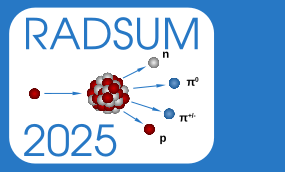Conveners
Overview of accelerator and fusion facilities and their radiation environments
- Simon Chislett-McDonald (Tokamak Energy Ltd)
Overview of accelerator and fusion facilities and their radiation environments
- Simon Chislett-McDonald (Tokamak Energy Ltd)
Superconducting magnets in high-energy particle colliders are often exposed to a harsh radiation environment. In many cases, the magnets need to be sufficiently shielded in order to dissipate the radiation-induced heat and to protect equipment against long-term radiation damage. The secondary radiation fields and shielding requirements must be thoroughly studied during the design phase of...
The J-PARC accelerator has been jointly operated by JAEA and KEK since 2007 and a variety of experiments has been carried out using secondary beams of pions, muons, neutrinos and other particles generated by proton beam with a power of several hundreds of kilowatts from 3 GeV Rapid Cycle Synchrotron and 30 GeV Main Ring. Superconducting (SC) magnets have been widely utilized in J-PARC. In...
The Paul Scherrer Institute (PSI) operates the world’s most powerful continuous beam proton accelerator, capable of delivering a beam current of up to 2.4 mA with a beam power of 1.4 MW. The proton beam is directed at two carbon targets, generating a large flux of pions and muons. The interaction between the beam and the targets, along with beam scattering, results in a significant radiation...
Superconducting magnets have been used for more than fifteen years in protontherapy systems, starting with NbTi (Varian, IBA) and Nb3Sn (Mevion). These magnets, designed with large temperature, field and current margins, proved to be reliable and show no sign of conductor performance degradation.
The development of HTS presents opportunities and triggers questions about their suitability for...
Among the key enabling technologies of compact fusion reactors there are high-temperature superconducting (HTS) magnets. Despite the great improvements recently achieved, one of the main challenges that still need to be faced is the evaluation of the impact of radiation in HTS tapes.
To face this challenge, it is crucial to have a comprehensive view of the radiation environment the HTS will...
The Spherical Tokamak for Energy Production (STEP) is the UK’s major technology and infrastructure programme to build a prototype fusion powerplant that will demonstrate net energy, fuel self-sufficiency and a viable route to plant maintenance.
STEP will use high temperature superconducting (HTS) magnet technology within toroidal and poloidal field (TF and PF) coils to confine the plasma....
During operation, ITER superconductive (SC) magnets are subjected to significant thermal loads which mostly result from the deposition of energy by plasma-generated neutrons, as well as from secondary gamma radiation produced when neutrons interact with matter. In addition to thermal loads, total neutron fluence and absorbed dose in key magnets components like the magnet’s insulators should be...
